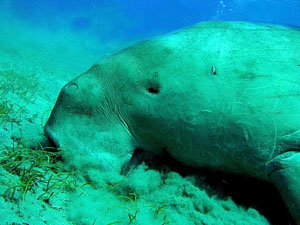What Is a Dugong?
Answer:

The dugong (Dugong dugon) is a large marine mammal which, together with the manatees, is one of four living species of the order Sirenia. It is the only living representative of the once-diverse family Dugongidae; its closest modern relative, Steller's Sea Cow (Hydrodamalis gigas), was hunted to extinction in the 18th century. It is also the only sirenian in its range, which spans the waters of at least 37 countries throughout the Indo-Pacific, though the majority of dugongs live in the northern waters of Australia between Shark Bay and Moreton Bay. The dugong is the only strictly-marine herbivorous mammal, as all species of manatee utilize fresh water to some degree.
Like all modern sirenians, the dugong has a fusiform body with no dorsal fin or hind limbs, instead possessing paddle-like forelimbs used to maneuver itself. It is easily distinguished from the manatees by its fluked, dolphin-like tail, but also possesses a unique skull and teeth. The dugong is heavily dependent on seagrasses for subsistence and is thus restricted to the coastal habitats where they grow, with the largest dugong concentrations typically occurring in wide, shallow, protected areas such as bays, mangrove channels and the lee sides of large inshore islands. Its snout is sharply downturned, an adaptation for grazing and uprooting benthic seagrasses.
The dugong has been hunted for thousands of years for its meat and oil, although dugong hunting also has great cultural significance throughout its range. The dugong's current distribution is reduced and disjunct, and many populations are close to extinction. The IUCN lists the dugong as a species vulnerable to extinction, while the Convention on International Trade in Endangered Species limits or bans the trade of derived products based on the population involved. Despite being legally protected in many countries throughout their range, the main causes of population decline remain anthropogenic and include hunting, habitat degradation, and fishing-related fatalities. With its long lifespan of 70 years or more, and slow rate of reproduction, the dugong is especially vulnerable to these types of exploitation. Dugongs are also threatened by storms, parasites, and their natural predators, sharks, killer whales, and crocodiles.
|